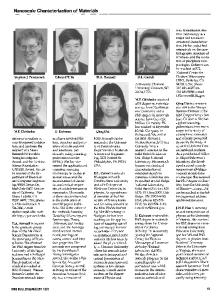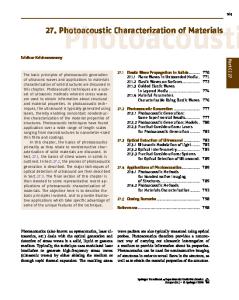The Role of Structure-to-Property-Relationships in Materials Characterization
- PDF / 3,217,079 Bytes
- 10 Pages / 414.72 x 639 pts Page_size
- 58 Downloads / 352 Views
ABSTRACT The paper deals with questions concerning the material characterization for steels in the field of engineering and metallurgy. Based on the structure-to-property-relationships, a procedure is proposed to strengthen the systematical development of methods for nondestructive characterization of materials. The state of the nondestructive characterization of metals is reviewed and applications are described in which adequate macroscopic physical properties are measured in order to characterize the materials state and properties nondestructively. The materials characterization of ball bearing steel and cast iron using multiparametrical approaches is discussed in detail. INTRODUCTION In contrast to the nondestructive inspection for defects, it is hard to find an approach for the nondestructive materials characterization which can be applied in a general way. The modeling of a general approach is difficult since the large number of structure parameters, of the varieties of chemical composition, of the bulk of geometry factors, of the stresses and mechanical quality parameters have a very complex influence of the physical properties like strength, hardness and toughness. Does that mean the methods of nondestructive materials characterization can be developed only in a trial-and-error approach? In fact, this is common practice if a materials identification problem has to be resolved, e.g. if excessively "hard" or excessively "soft" components have to be separated. Even if the experimental attitude turns out sometimes to be successful it is much more straight forward to consider the inter-correlation between microstructure and properties. It is evident that the state of the material of a certain component, described in terms of hardness, strength, toughness and wear resistance, depends on the materials structure as it has been developed during the different steps of the manufacturing process. With this in mind, it is possible to accomplish materials characterization in an indirect approach, i.e. through nondestructive testing. However, methods developed on these grounds should not be considered and evaluated as a nondestructive "substitute" for hardness, strength and toughness. In contrast, such methods are usually capable of characterizing the state of a material in much more comprehensive terms that one could achieve, typically, by surface hardness testing. This is not considered to debase hardness testing, which, when modem computerized surface-mounted hardness testers are used, does represent an acceptable, virtually nondestructive method. The structure of materials and, hence, their physical properties, are influenced at every stage of manufacturing, considering just the processes of casting, rolling, forging, annealing, 119 Mat. Res. Soc. Symp. Proc. Vol. 591 @2000 Materials Research Society
hardening, as well as deviations in quality as may occur, such as coarse grain, decarburization, carburization and so on. Changes in physical properties may be enormous in the case of deviations in quality. Typically, in
Data Loading...











